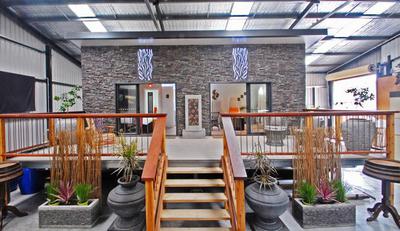Energy-positive prefab housing can tackle Australia’s big issues
by Willow Aliento
(thefifthestate.com.au)
An innovative Australian company is tackling a number of our pressing problems in one flat-packed prefab package – supporting regional communities and jobs, creating new avenues for Australian manufacturing, and solving energy supply and building sustainability issues.
Colin Ure is a man with a major mission – to see housing become essential energy-generating infrastructure. And his company, iCUE Homes, has projects in the pipeline that look set to prove the case.
The company has designed a prefabricated tiny home that can operate entirely off-grid for energy and water. It can also be flat-packed to send anywhere in the world.
Ure says it all started with researching to find a self-contained unit for his own block in Healesville, Victoria. But none of the manufactured housing companies could give him a quote from “foundation to ceiling”.
Then he happened to come across someone that had invented a concrete-free foundation system, Surefoot. It uses pile driving technology to drive steel pipes into the ground, which then have plates affixed to which trusses can be attached.
Colin Ure
Ure says the system takes 10 minutes to put in place – with no earthworks or concrete required.
From there, he evolved the design of a prototype house that uses structural insulated panels for walls, double glazing, and insulated roof and flooring to create a home with an energy rating of between 8 and 10 star NatHERS.
The homes also have solar PV and batteries, a geothermal air management system, waterless composting toilets, a prototype portable grey water treatment system Ure designed himself, rainwater harvesting and underfloor water storage.
The whole kit, including furniture, can be flat-packed into a 40-foot shipping container and sent anywhere in the world, he says. And when it arrives at location, the container itself becomes part of the home as an added bedroom, workshop, laundry or other space.
It is also suitable for just about anywhere, with a Bushfire Attack Level rating of 40, and cyclone-resistant design and foundations.
The first home was purchased and installed at Gembrook, 50 kilometres south-east of Melbourne, and has been operating off-grid and energy-positive for the past two years.
At Sustainable House Day on 17 September, Ure is opening the factory to showcase the Waurang prototype, a similar home to the Gembrook property. It costs about $145,000, he says, and buyers would never have an energy bill again.
A number of orders are in progress, including two for self-contained accommodation in Healesville, 50km north-east of Melbourne, where the factory is based.
A three bedroom R&D home is also set to be constructed at nearby Marysville, with the CSIRO on board to carry out monitoring of the home and its performance.
The Marysville property will also act as a project display home, and be opened for visitors about 24 times a year, Ure says.
In South Gippsland, a pilot involving a cluster of 13 of the tiny homes is in the development approval stages, and another cluster of 60 is also on the drawing board.
These clusters of homes will be energy positive, and in a position to sell energy into the grid, Ure says.
Clusters of homes could rival power plants
A cluster of 5000 could, he says, generate as much power as the Port Augusta solar thermal project.
That’s the exciting big picture he sees – combining housing with energy generation and off-grid water systems so whole towns and cities can be built without needing energy and sewerage infrastructure.
“It’s a permaculture house,” he says.
The manufacturing approach has focused exclusively on Australian-made materials, products and technology, which is also of Ure’s vision.
“Five years ago I was working in the forklift industry, and when I heard about the car manufacturing industry shutting down, I figured I’d be out of a job. So I went looking for something to replace that,” he says.
The multiple levels he wants to address also include supporting regional communities and jobs, creating new avenues for Australian manufacturing, solving the problem of “energy sucking houses” and solving our issues with energy supply and sustainability all in one flat-packed prefab package.
Printing homes
The manufacture of the houses themselves can be scaled up, he says. They can be virtually “printed”.
“You can manufacture them like you do a motor vehicle.”
There are new design tweaks in the works too, including having homes with pylons on the side and a pontoon underneath, so in event of a flood the home can rise and fall with the water.
Another innovation he is designing into future homes is an Australian developed air management system, Sisacs, that draws drinking quality water out of the air as it purifies the air.
Currently, the company is speaking with a major energy gentailer, the Clean Energy Council and the Victorian Department of Land, Water, Environment and Planning about possibilities for engaging in a scale-up.
The proposition is that this is a way to make energy infrastructure “cost neutral” as it is housing people at the same time as it generates sellable power – and the purchaser of the home is the one paying for the infrastructure, while also saving thousands of dollars on energy costs.
The evolution of peer-to-peer trading also helps to make this really viable to install.
Even Antarctica’s interested
Ure says talks are underway with the Antarctic research team in Tasmania about designing a product for the research station on Macquarie Island in Antarctica.
The company is also recruiting a junior investment partner to bring senior investment partners on board, Ure says.
“With the flood of work coming in, we could see fast progress to 500 to 600 houses being completed.”
Join in and write your own page! It's easy to do. How? Simply click here to return to News portal.



